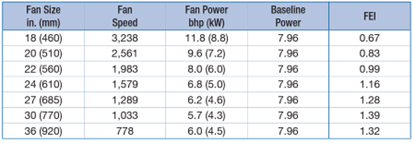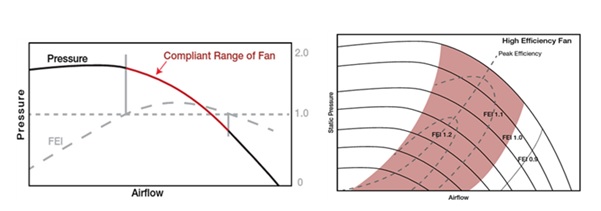What you need to know about ASHRAE 90.1-2022, FEG, and FEI - Part II

In our previous blog post, we explained the inconsistencies that were in the Fan Efficiency Grade metric (FEG) which was included in ASHRAE Standard 90.1-2019 and other energy standards. Because of these inconsistencies, the FEG metric could not accurately define the most energy-efficient fan for an application. This led to FEG being replaced with a more comprehensive fan energy-saving metric, the Fan Energy Index or FEI. This blog post will acquaint you with the FEI metric and help you understand the benefits it offers your firm in selecting fans that will reduce energy consumption.
Previous methods of selecting an efficient fan were based on the fan shaft input brake horsepower or the fan’s efficiency at a required duty point (cfm and static pressure). Neither of these methods considers the power loss due to the fan’s motor and drive inefficiency. If reducing electric energy consumption in fan applications is of concern, it makes sense to compare the electrical power input of one fan selection to another. The FEI metric assists you in doing just that—selecting the fan with the lowest input electrical power consumption. The FEI metric includes electrical power input to the fan system including the efficiency impact of the motor and drive.
 |
| Figure 1: Comparison of Fan Energy Index (FEI) and Fan Efficiency Grade (FEG) |
The FEI metric makes picking the most energy-efficient fan for an application simple by selecting the fan on electrical power (energy) consumption and not fan efficiency alone as highlighted in green in Figure 1.
A correlation exists between fan power consumption and fan efficiency; however, fan applications vary greatly resulting in different power (energy) consumption in different applications for the same fan. Since the goal is to minimize fan power, the FEI metric is defined as a ratio of the maximum allowed to actual power inputs:
FEI= FEPb / FEPi
Where: FEPb is the Baseline Fan Electrical Input power, and
FEPi is the fan’s actual electrical input power
FEPb - The Baseline Fan Electrical Input power, or the maximum allowed electrical power input is of a conceptual fan capable of producing the required airflow and pressure, at a specified shaft input power using a v-belt drive and having a motor efficiency based on a 4 pole, 60Hz, IE3 motor that does not include a speed control.
FEPi - The actual fan electrical input power is obtained by measured fan electrical input power or by applying default values for motors and drives defined in AMCA Standard 207 to the measured fan shaft power. Either the electrical power input or fan shaft power input is obtained during certified rating tests in accordance with AMCA Standard 210. Both FEPb and FEPi are defined in AMCA Standard 214.
The beauty of the FEI metric is that if the FEI value of a fan in an application is 1.0, its input power is equal to and meets the required baseline input power. If the FEI value of a fan in an application is 1.1, the fan is 10% more efficient. The FEI metric is useful, functional, and easy to understand.
How is the FEI metric applied and used?
Regulatory authorities such as the U.S. Department of Energy or local energy codes based upon current energy standards (IECC, ASHRAE 90.1, ASHRAE 189.1, IgCC, CEC Title 20, etc.) state that applicable fans have an FEI of 1.0 or greater. Manufacturers that have fans with FEI-certified ratings listed in accordance with AMCA 210 can present FEI data for several fan sizes with the same application duty point (flow, pressure) in tabular form.
Table 1 illustrates this and the ease of using the FEI metric in identifying the most efficient fans, saving the most input electrical power. This example is for applying a fan with a design duty point of 10,000 cfm (4,719 l/s) at 3 inches (747 pascals) static pressure. Fan sizes 18, 20, and 22 use more electrical power with an FEI < 1.0 and should not be selected.
 |
| Table 1: Data comparing FEI for multiple sizes of the same fan model for a specific design duty point. |
Manufacturers can also graphically present both fan performance and the FEI metric for a specific fan duty point as shown in Figures 2 and 3 below.
 |
Figure 2: (at left) Compliant range of operation of a fan operating at a single speed. Figure 3: (at right) Compliant range of operation of a fan operating at multiple speeds. |
Beyond Efficiency
In addition to overall fan efficiency, you will also notice in Figure 2 that by optimizing FEI, the fan selection ends up being more central in the fan curve. This provides the design engineer more comfort against unforeseen static pressure impacts in the field. A less efficient fan may be selected closer to the max RPM line on the curve and could result in underperformance if the actual static pressure exceeds what was calculated during the design.
Lastly, you will notice that the FEI increases as the fan speed goes down. This can often translate to quieter fan operation as well. This is additional protection for the design engineer (and building occupants) against unwanted noise levels in sound-sensitive applications.
Call To Action
1. Include FEI in your fan schedules
Greenheck includes FEI metrics on applicable fan products in its eCAPS® online product selection program that allows you to select the best value product for your application. Click here to access eCAPS®.


from